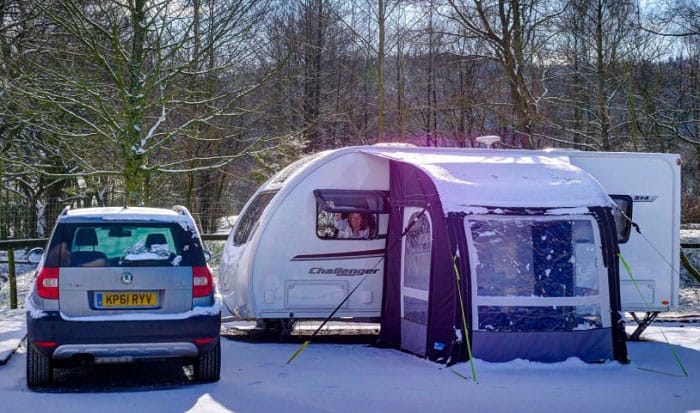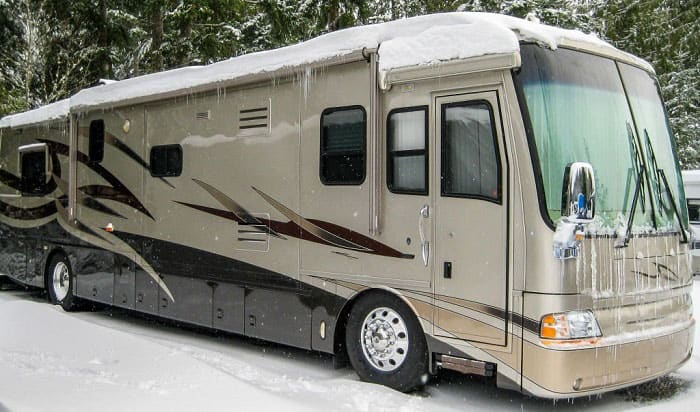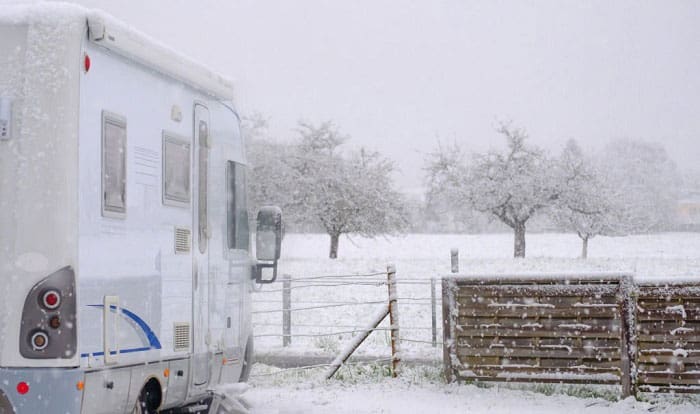Failing to winterize an RV’s water lines can cause them to become susceptible to freezing temperatures. If so, the water pipes can expand and burst. Now you’re wondering about the steps on how to keep RV pipes from freezing while camping.
Getting the necessary items like the correct drain socket and a trustworthy antifreeze should be the first steps to keeping the pipes in the RV from freezing. Then, you can follow the proper procedure in applying the camper anti-freezing solution step by step.
Always remember that applying the antifreeze to the RV haphazardly can increase the risks of ruining the camper’s plumbing system.
Table of Contents
What You’ll Need for This Tutorial
Part of this guide on winter RV camping tips is this list of items you need to secure to help keep your RV pipes from freezing because of cold temperatures. The equipment you should prepare to ensure your pipes don’t freeze from the cold weather.
1. Drain Socket
Also called a drain plug kit, a drain socket generally comes in two sizes. 7/8-inch models usually fit Atwood hot water heaters. On the other hand, 1-1/16-inch sockets typically fit heaters made by Suburban.
RV owners should check their water heater or rigs’ owner’s manuals to know the correct model of the water-heating system. Make sure that the drain plug kit you purchase and install is compatible with your RV’s water heater.
Some reliable brands develop trustworthy drain plug kits. Two excellent examples include Camco and RVMATE, which generally have proven track records in providing noteworthy aftermarket parts for different RVs.
2. Bypass Valve System
Many RVs should already have bypass valves. Generally, these systems should be outside rigs and typically look like rectangular or square compartments. These casings may also have pull-down notches or panels to promote easy access.
If your RV doesn’t have this system or is faulty, it can be a practical choice to buy and install one before proceeding with the steps to prevent your RV pipes from freezing while camping.
Keep in mind that the main function of a bypass valve system is to prevent the antifreeze from going into the water heater holding tank. Doing so allows the water heater to allow hot water to flow to the hot water line.
3. Antifreeze
It’s best to choose the correct winterizing product to prevent freezing for your RV’s pipes. Paying attention to certain factors can help make the purchasing decision as hassle-free as possible.
Buyers should take note of the different factors when looking for the best anti-freezing solution for their camping vehicles. For instance, ensure that it has a non-toxic formula to avoid issues in using the product near kids and pets.
Also, it can be a good idea to buy a product that comes diluted or pre-mixed. Doing so will help save you time and effort so you can head straight to using the solution on your RV’s plumbing system.
4. Towels
Prepare for spills and messy applications by surrounding your work area with towels. If you don’t have several towels lying around your RV, you may also use an old yet reasonably large blanket or bed sheet.
5. Sewer Hose
Sewer hoses are essential items for RV owners as some camping grounds require them. For example, some camping sites in Arizona prohibits rig users from staying at these locations if they don’t have these hoses.
Also, having this hose can help with draining black, gray, and freshwater tanks directly into the city’s sewer line. Without this item, it can be difficult to control the water coming from these reservoirs.
Step-by-Step Instructions
Take note that trying to keep trailer pipes from freezing without following the recommended procedure can be a recipe for disaster. Follow these steps to ensure you’re winterizing RV for winter living correctly.
Step #1: Drain the Water Tanks
Make sure that the water system is empty. At this point, you need to drain the RV’s water supply. Otherwise, water, especially the particulates, may create an adverse effect when mixed with the antifreeze.
Then, drain the black water tank. Do the same with the gray water tank afterward. Remove the water from both the hot and cold water lines. You’ll know when to stop if the remaining water from the faucets or taps only comes out as trickles.
Step #2: Remove Pressure from Hot Water Heater
Make sure to stay away from the heating unit while the excess air is escaping from it. The warm air might burn your skin if you’re sitting or standing close to it. Ensure that you’re using the correct drain socket for this step.
Step #3: Bypass the Hot Water Heater Connection
Many RVs should already have a bypass valve system. If not, you may need to secure one by going to your local hardware stores before proceeding with this step.
With the bypass valve system ready, turn the valves on both the hot and cold lines. Then, turn the valve on the bypass system. The result should make the bypass valve parallel to the bypass line.
On the other hand, one-valve systems only demand to close the valve. That way, it’ll become perpendicular to the cold water pipeline. Take note that you also need to bypass the water filter if you have this component.
Step #4: Check the Water Flow
You can check if you did this part of the process correctly if the RV’s water detours from the water tank and goes through the cold and hot lines directly. Take note that this valve-turning procedure should be similar to both two- and three-valve bypass systems.
Step #5: Attach the Antifreeze
With the bypass valve system still installed, add antifreeze into the RV plumbing. Place towels around the RV holding tanks for you might experience some spillage when the antifreeze flows through the lines.
Make sure to disconnect the fresh water hose from the main water pump and the fresh water tank. Connect the bypass system to the water pump side and place the other end of the hose into the RV antifreeze container.
Generally, it takes about 2 to 3 gallons of non-toxic antifreeze to keep RV water lines from freezing. Make sure that you’re using the correct solution to winterize a camper to live in because some products might contain harsh chemicals.
Adding other chemical solutions other than the recommended products to keep RV pipes from freezing may promote adverse effects.
Step #6: Turn on All Water Outlets
Close all drain plugs located outside the RV. Then, activate the main water pump. Next, turn on every water outlet in the camper. However, make sure you run each outlet individually. Turn off each water outlet when you see a bit of antifreeze coming out.
Don’t forget to include the toilet when you’re doing this step. Flush it until you see some antifreeze coming out. Turn off the main water pump after removing water from every water tank in the rig.
Finally, load up the check-valve line with the sewer hose. Make sure that the main water pump is in the off position for this step. Hold the valve inside the check-valve line until you see a bit of antifreeze. Once complete, reconnect the main water pump.
How Do You Know If Your RV Pipes Froze?
Aside from the obvious signs of frost buildup on your RV’s plumbing system, other indicators of frozen pipes in your rig are:
- No water coming out of the faucets and plumbing fixtures.
- Strong smell from the drains.
- Visible signs of burst pipes.
- Water leaking into your camping vehicle.
How Cold Is Too Cold For RV Water Lines?
Generally, RV pipes freeze when they reach below freezing temperatures or 32 degrees Fahrenheit. The average winter temperature is about 19.7 degrees Fahrenheit in many states, with Alaska having the lowest.
However, some states have temperature drops to only about 33.2 degrees Fahrenheit for their winter weather. That low reading might not be enough to incur frozen pipes. Still, camper users should use essential winterizing methods to prevent their vehicles’ plumbing systems from being likely to freeze.
Aside from using antifreeze, RV owners can also apply other techniques to ensure their pipes don’t freeze. Some alternate methods to try to prepare for temperature drops during an RV camping trip are:
- Apply heat tape to the pipes in the camper.
- Insulate the motorhome doors and windows.
- Install foam insulation in the vehicle.
- Upgrade the RV skirting to prevent cold air from entering the vehicle.
- Use a space heater.
- Take advantage of heating pads on the RV’s fresh water tank.
How to Thaw Frozen RV Pipes?
Human error may permit some pipes in your RV to freeze in the winter. If so, you can use the following options to thaw your RV’s frozen pipes safely:
1. Space Heaters
A space heater can be ideal for applying a sufficiently warm temperature near your camper’s plumbing lines. With this method, make sure that you monitor the portable heater at all times. If left alone, some parts of your RV may catch fire.
2. Heat Gun
Using a heat gun or a hairdryer can be a good option to properly thaw your RV’s frozen pipes. This tool is often best for use on copper or metal pipes. You can use a heat gun on your PVC pipes, provided that you’re being more careful than usual with it.
On the other hand, a heat gun or a hairdryer might not be ideal if you’re not too keen on the idea of using a handheld thawing tool for extended periods.
3. Professional Services
Suppose you’re not confident with your skills in maintaining your RV’s plumbing system. In that case, it can be a practical choice to call for professional help. Consult the expert aid of a certified plumber as the technician.
The plumbing expert should already have the necessary experience, knowledge, and skills in thawing RV pipes. That professional may also assist you in other plumbing problems seen during the repair operation.
4. Wait it Out
Bear in mind that it can take anywhere from 30 minutes to several days for RV pipes to unfreeze naturally. The weather can play an integral role in thawing the frozen plumbing lines.
Also, it may take longer than usual to unfreeze the pipes if you park your camper in a particularly cold location. Use the other methods mentioned above if you don’t want to wait longer than necessary for the pipes to thaw.
Conclusion
Did you enjoy reading this post on how to keep RV pipes from freezing while camping? What did you think about it? Don’t forget to share your thoughts and experiences in winterizing your RV in the comment section.
Remember, take the time to search for the right RV anti-freezing solution. Then, follow the recommended steps to use that product to ensure your camper’s pipes don’t freeze in the winter.

Hi, I am Joseph. Carpe diem! Seize the day! That’s always been my life motto. If you haven’t seen some of the most beautiful places in the country, you are missing out on incredible adventures.




